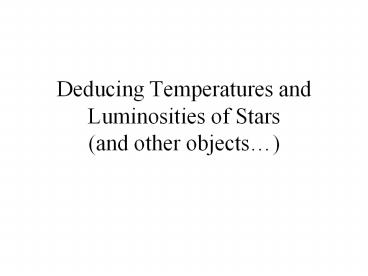Deducing Temperatures and Luminosities of Stars (and other objects - PowerPoint PPT Presentation
1 / 19
Title:
Deducing Temperatures and Luminosities of Stars (and other objects
Description:
Deducing Temperatures and Luminosities of Stars (and other objects ) – PowerPoint PPT presentation
Number of Views:136
Avg rating:3.0/5.0
Title: Deducing Temperatures and Luminosities of Stars (and other objects
1
Deducing Temperatures and Luminosities of
Stars(and other objects)
2
Review Electromagnetic Radiation
Increasing energy
10-15 m
103 m
10-6 m
10-2 m
10-9 m
10-4 m
Increasing wavelength
- EM radiation consists of regularly varying
electric magnetic fields which can transport
energy over vast distances. - Physicists often speak of the particle-wave
duality of EM radiation. - Light can be considered as either particles
(photons) or as waves, depending on how it is
measured - Includes all of the above varieties -- the only
distinction between (for example) X-rays and
radio waves is the wavelength.
3
Wavelength
?
- Wavelength is the distance between two identical
points on a wave. (It is referred to by the
Greek letter ? lambda)
4
Frequency
time
unit of time
- Frequency is the number of wave cycles per unit
of time that are registered at a given point in
space. (referred to by Greek letter ? nu) - It is inversely proportional to wavelength.
5
Wavelength andFrequency Relation
? v/?
- Wavelength is proportional to the wave velocity,
v. - Wavelength is inversely proportional to
frequency. - eg. AM radio wave has a long wavelength (200 m),
therefore it has a low frequency (KHz range). - In the case of EM radiation in a vacuum, the
equation becomes
????c??
Where c is the speed of light (3 x 108 m/s)
6
Light as a Particle Photons
- Photons are little packets of energy.
- Each photons energy is proportional to its
frequency. - Specifically, each photons energy is
E h?
Energy (Plancks constant) x (frequency of
photon)
7
The Planck function
- Every opaque object (a human, a planet, a star)
radiates a characteristic spectrum of EM
radiation - spectrum (intensity of radiation as a function of
wavelength) depends only on the objects
temperature - This type of spectrum is called blackbody
radiation
visible
infrared
radio
ultraviolet
Intensity (W/m2)
0.1
1.0
10
100
1000
10000
8
Temperature dependence of blackbody radiation
- As temperature of an object increases
- Peak of black body spectrum (Planck function)
moves to shorter wavelengths (higher energies) - Each unit area of object emits more energy (more
photons) at all wavelengths
9
Wiens Displacement Law
- Can calculate where the peak of the blackbody
spectrum will lie for a given temperature from
Wiens Law
????5000/T
Where ? is in microns (10-6 m) and T is in
degrees Kelvin (recall that human vision ranges
from 400 to 700 nm, or 0.4 to 0.7 microns)
10
Colors of Stars
- The color of a star provides a strong indication
of its temperature - If a star is much cooler than 5,000 K, its
spectrum peaks in the IR and it looks reddish - It gives off more red light than blue light
- If a star is much hotter than 15,000 K, its
spectrum peaks in the UV, and it looks blueish - It gives off more blue light than red light
11
Betelguese and Rigel in Orion
Betelgeuse 3,000 K (a red supergiant)
Rigel 30,000 K (a blue supergiant)
12
Blackbody curves for stars at temperatures of
Betelgeuse and Rigel
13
Luminosities of stars
- The sum of all the light emitted over all
wavelengths is called a stars luminosity - luminosity can be measured in watts
- measure of stars intrinsic brightness, as
opposed to what we happen to see from Earth - The hotter the star, the more light it gives off
at all wavelengths, through each unit area of its
surface - luminosity is proportional to T4 so even a small
increase in temperature makes a big increase in
luminosity
14
Consider 2 stars of different Ts but with the
same diameter
15
What about large small stars of the same
temperature?
- Luminosity goes like R2 where R is the radius of
the star - If two stars are at the same temperature but
have different luminosities, then the more
luminous star must be larger
16
How do we know that Betelgeuse is much, much
bigger than Rigel?
- Rigel is about 10 times hotter than Betelgeuse
- Rigel gives off 104 (10,000) times more energy
per unit surface area than Betelgeuse - But the two stars have about the same total
luminosity - therefore Betelguese must be about 102 (100)
times larger in radius than Rigel
17
So far we havent considered stellar distances...
- Two otherwise identical stars (same radius, same
temperature gt same luminosity) will still appear
vastly different in brightness if their distances
from Earth are different - Reason intensity of light inversely proportional
to the square of the distance the light has to
travel - Light wave fronts from point sources are like the
surfaces of expanding spheres
18
Stellar brightness differences as a tool rather
than as a liability
- If one can somehow determine that 2 stars are
identical, then their relative brightnesses
translate to relative distances - Example the Sun and alpha Centauri
- spectra look very similar gt temperatures, radii
almost identical (T follows from Planck function,
radius can be deduced by other means) gt
luminosities about the same - difference in apparent magnitudes translates to
relative distances - Can check using the parallax distance to alpha Cen
19
The Hertsprung-Russell Diagram































